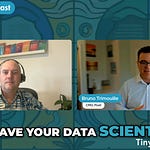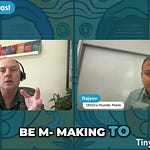Listen now on YouTube | Spotify | Apple Podcasts
ChatGPT arrived in late 2022 and changed everything.
AI wasn't background technology anymore. It sat on our desktops, ready to write emails, create content, and answer questions. The technical barriers disappeared overnight. Every marketer was able to access the same AI tools that formerly required a PhD in computer science.
This accessibility shift created the great wake-up call of the 2020s. AI skills have become as basic as knowing Excel or email. Companies and individuals who ignore this shift will fall behind fast.
About Judit
Judit Szabo led one of the biggest AI rollouts I've seen. As Global Head of Demand Generation and Operations at Endava, the company trained all 12,000 employees on AI tools. Her company now runs over 3,000 custom GPTs. Her perspective cuts through the hype with real implementation experience.
What you'll learn in this post
Why Endava's lead automation took months to reach proof-of-concept
How "survival of the nimblest" became the new competitive advantage
Why physical events and human connections matter more now, not less
The voluntary adoption strategy that eliminated resistance across 12,000 employees
How to maintain quality control when running 3,000 custom GPTs
"What was very new with generative AI is it's accessible for everyone, and it's not a choice anymore. If you don't treat it as part of your workforce, as your teammate, as your assistant, then you are already behind."
— Judit Szabo, Global Head of Demand Generation and Operations, Endava
Why most AI projects fail before they start
Endava's team spent months trying to build an automated lead management system. They wanted AI to handle everything from initial contact through qualification. The project took months just to reach the proof-of-concept stage.
Why? You can't automate a broken process and expect it to work better.
"You can't apply AI on rigid, only one-time models, or it breaks down, or it's not going to be efficient. You need to nail your process before you can scale it."
— Judit Szabo, Global Head of Demand Generation and Operations, Endava
Your data creates another killer problem. Most enterprise companies struggle with data connectivity. Customer information lives in your CRM. Engagement data sits in your marketing automation platform. Product usage hides in analytics tools. Support tickets exist in another system.
AI doesn't solve this problem. It makes the mess more obvious and infuriating.
"If your underlying data is bad, then your output will be bad. If your underlying infrastructure is not modern and agile, and the data points are not talking to each other, then your output is garbage."
— Judit Szabo, Global Head of Demand Generation and Operations, Endava
Judit learned this when she tried using AI for marketing analytics. The results looked impressive. She compared them to her manual analysis. The AI missed context that only came from understanding how different data sources were interconnected.
The survival advantage of the nimblest
The best AI results don't come from prompt engineers. They come from people who know what good work looks like.
Judit's design team started using AI for image creation. The experienced designers created unique, on-brand visuals immediately. Other team members got generic stock photo-style images.
"This is the age of the survival of the nimblest. I wouldn't be able to create that output that our designers do, because they have the context of where they want to use it. They have the vision of what they want to see, and they have the knowledge of how to put the prompts together."
— Judit Szabo, Global Head of Demand Generation and Operations, Endava
The difference wasn't technical skill. The designers knew what good design looked like. They understood brand guidelines. They could picture the final result before they started.
AI models train to be reliable and predictable. They're not great at bold new ideas or challenging conventional thinking.
"I don't know how much an AI model can be bold, because I think they are trained to be reliable. And it's based on historic knowledge and data."
— Judit Szabo, Global Head of Demand Generation and Operations, Endava
Why human connections matter more, not less
Endava's biggest surprise wasn't about the technology. It was about what their customers valued.
When they relaunched their website, they invested significant time and money photographing real employees across their global offices. The site featured authentic photos of actual team members in different locations and settings. But this created challenges. What happens when employees leave? What if someone asks to have their photo removed from the website?
AI-generated images seemed like the perfect solution. Their experienced designers could create unique, on-brand visuals with precise prompts. These would be one-of-a-kind images that no other company could use. But despite the practical advantages, the human element remained important for their B2B customers.
"In services, in consultancy, we see that maybe more than in software—you need the trust of that customer, you need the buy-in of the C-level, the board to come along. So I can't automate that. I need to introduce the human element at certain touch points."
— Judit Szabo, Global Head of Demand Generation and Operations, Endava
Physical events bounced back stronger than expected after the pandemic. After years of virtual meetings, people want face-to-face conversations again.
"The importance and prevalence of physical events have come back into the picture. Someone picking up the phone and trying to have that meaningful, really, truly meaningful conversation with you, understanding your business needs—I haven't seen an AI workflow that would be able to do that."
— Judit Szabo, Global Head of Demand Generation and Operations, Endava
AI search results reflect this trend too. Platforms like Reddit became more influential in search rankings. They feature authentic human opinions and experiences. People trust peer reviews and real user feedback more than polished marketing content.
How to drive adoption without fear
Knowing what to do and getting 12,000 people to do it are different challenges.
Endava started with volunteers instead of mandates. They announced a pilot program. People could participate if interested. No pressure. No requirements.
"We spread the word of, like, okay, we're launching this. It's potentially going to be very influential and important. But it's not mandatory. Come if you want. Otherwise, no. Then we just started to compile the use cases, inspiring each other, what could we use this for?"
— Judit Szabo, Global Head of Demand Generation and Operations, Endava
This voluntary approach attracted motivated early adopters. They became internal champions. It removed the fear factor. The team saw results. Word spread naturally. The voluntary program created genuine demand instead of resistance.
Judit had to be direct about the future though. AI skills weren't staying optional.
"One of the most highly sought after skills of a marketer is whether you have AI skills. It's not going to take your job, because you will have to work with AI. But if you don't experiment with it, and you're not already leading the pack, you will fall behind."
— Judit Szabo, Global Head of Demand Generation and Operations, Endava
For quality control, Endava puts experienced humans at key checkpoints. They require AI training before tool access. Every employee completes training, then gets access to enterprise GPT and custom tools designed for specific business needs.
"We've had the whole company, all 12,000 employees go through AI training, and everyone now has access to enterprise GPT. But you can't get access to the tool until you do that training. We have 3,000 GPTs now built custom within the company."
— Judit Szabo, Global Head of Demand Generation and Operations, Endava
Their most popular internal GPT? The one that helps people find other GPTs.
The bottom line for marketing leaders
AI handles more routine tasks. Human connections become more valuable, not less. The most successful marketing organizations will use AI to amplify human capabilities rather than replace them.
Use AI to speed up productivity and handle repetitive work. Invest equally in strengthening the human elements that build trust, drive bold decisions, and create value that no model can replicate.
The marketing leaders who thrive won't be the ones with the best AI tools. They'll be the ones who best understand when to use those tools and when to rely on human judgment instead.
"Don't underestimate the power of the human connections, because I think that's only going to become stronger, somehow weirdly, in a very counterintuitive way, it might become more important."
— Judit Szabo, Global Head of Demand Generation and Operations, Endava
The wake-up call isn't just about adopting AI. It's about understanding that the companies that figure out this balance first will have a big advantage over those that don't.
Based on insights from Judit Szabo, Global Head of Demand Generation and Operations at Endava, a 12,000-person IT services consultancy that has implemented AI across the organization while maintaining focus on human-centered client relationships.
About David Sweenor
David Sweenor is an AI, Generative AI, and Product Marketing Expert. He brings this expertise to the forefront as founder of TinyTechGuides and host of the Data Faces podcast. A recognized top 25 analytics thought leader and international speaker, David specializes in practical business applications of artificial intelligence and advanced analytics.
Books
Artificial Intelligence: An Executive Guide to Make AI Work for Your Business
Generative AI Business Applications: An Executive Guide with Real-Life Examples and Case Studies
The Generative AI Practitioner's Guide: How to Apply LLM Patterns for Enterprise Applications
The CIO's Guide to Adopting Generative AI: Five Keys to Success
Modern B2B Marketing: A Practitioner's Guide to Marketing Excellence
The PMM's Prompt Playbook: Mastering Generative AI for B2B Marketing Success
With over 25 years of hands-on experience implementing AI and analytics solutions, David has supported organizations including Alation, Alteryx, TIBCO, SAS, IBM, Dell, and Quest. His work spans marketing leadership, analytics implementation, and specialized expertise in AI, machine learning, data science, IoT, and business intelligence.
David holds several patents and consistently delivers insights that bridge technical capabilities with business value.
Follow David on Twitter @DavidSweenor and connect with him on LinkedIn.
Podcast Highlights - Key Takeaways from the Conversation
Judit's Career Journey and Entry into AI
[2:05] "I graduated in English and French studies. I stayed at the university to do PhD in English... But then, luckily, by the end of my PhD studies, I had a moment of reflection where I thought, I'm maybe a little bit more pragmatic than this domain."
[6:14] "That was 2009 and quite embarrassed that I had to ask that question [about what Cloud means]. But I guess that was my task, to translate all of the technical verbiage into consumable messaging."
The AI Wake-Up Call
[6:55] "What was very new with generative AI is it's accessible for everyone, and it's not a choice anymore. If you don't treat it as part of your workforce, as your teammate, as your assistant, then you are already behind."
[8:41] "It kind of shakes things up and then levels things out. It kind of puts everyone back to the same starting line."
Why AI Projects Fail
[12:43] "You can't apply AI on rigid, only one-time models, or it breaks down, or it's not going to be efficient. You essentially have to nail your process before you can scale it."
[25:51] "If your underlying data is bad, then your output will be bad. If your underlying infrastructure is not modern and agile, and the data points are not talking to each other, then again, your output is going to be garbage."
The Age of the Nimblest
[13:21] "This is the age of the survival of the nimblest."
[12:27] "I wouldn't be able to create that output that our designers do, because they have the context of where they want to use it. They have the vision of what they want to see, and they have the knowledge of how to put the prompts together."
[21:43] "I don't know how much an AI model can be bold, because I think they are trained to be reliable. And it's based on historic knowledge and data."
The Human Connection Paradox
[18:27] "In services, in consultancy, we see that maybe more than in software—you need the trust of that customer, you need the buy-in of the C-level, the board to come along. So I can't automate that. I need to introduce the human element at certain touch points."
[24:36] "The importance and prevalence of physical events have come back into the picture. Someone picking up the phone and trying to have that meaningful, really, truly meaningful conversation with you, understanding your business needs—I haven't seen an AI workflow that would be able to do that."
Driving AI Adoption Without Fear
[34:14] "We spread the word of, like, okay, we're launching this. It's potentially going to be very influential and important. But it's not mandatory, you know. Come if you want. Otherwise, no. Then we just started to compile the use cases, inspiring each other, what could we use this for?"
[37:43] "One of the most highly sought after skills of a marketer is whether you have AI skills. It's not going to take your job, because you will have to work with AI. But if you don't experiment with it, and you're not already leading the pack, you will fall behind."
Quality Control at Scale
[31:51] "I would put these experienced humans as the reviewers of the outputs or the models as a spot check, or sanity check, to ensure that it works. I would always have a human at the beginning to ensure that you put the vision forward, and then at the output, really reviewing it and just contextually consuming it—does this make sense?"
[38:51] "We've had the whole company, all 12,000 employees go through AI training, and everyone now has access to enterprise GPT. But you can't get access to the tool until you do that training. We have 3,000 GPTs now built custom within the company."
Final Wisdom
[38:10] "Don't underestimate the power of the human connections, because I think that's only going to become stronger, somehow weirdly, in a very counterintuitive way, it might become more important."
Listen to the full conversation with Judit Szabo on the Data Faces Podcast.











